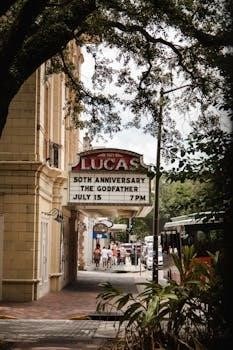
The Godfather PDF⁚ An Overview
The digital format of “The Godfather” provides convenient access across various platforms. Readers can find the book available as a PDF, enabling reading on devices like computers, tablets, and smartphones. This format offers accessibility and portability, making it easy to enjoy Mario Puzo’s classic novel.
Availability of the eBook
The eBook version of “The Godfather” is widely available, catering to a broad audience seeking digital access to Mario Puzo’s renowned novel. Numerous online platforms offer the PDF format, allowing readers to download and enjoy the book on various devices. These platforms range from dedicated eBook retailers to online libraries and archives, ensuring that the digital version is easily obtainable; The widespread availability of the PDF format makes it convenient for readers to access the book regardless of their location or preferred reading device. This ease of access contributes to the continued popularity and readership of “The Godfather,” ensuring its legacy endures in the digital age. Many websites also offer free versions of the book, though it’s essential to verify the legitimacy of these sources to ensure safe downloads. This accessibility makes the eBook a popular choice for those wishing to delve into the world of the Corleone family. Furthermore, the PDF format retains the original formatting of the book, allowing readers to have a similar experience to reading a physical copy.
Online Reading Platforms
Several online platforms offer options for reading “The Godfather” in digital formats. Some websites provide online readers, allowing users to access the book directly through their web browsers without needing to download a file. These platforms often feature user-friendly interfaces and customizable reading settings. Other sites allow users to upload their own PDF copies of the book for online reading. Many online libraries also host the digital version of “The Godfather”, offering free or subscription-based access. These platforms provide a convenient alternative to purchasing a physical copy, enabling readers to enjoy the novel on various devices. Moreover, some of these platforms allow users to create accounts, saving their reading progress and preferences. This wide range of options ensures that readers can find a platform that suits their individual needs, making it easier than ever to delve into the world of the Corleone family. Furthermore, some platforms may offer additional features, such as built-in dictionaries or note-taking tools, enhancing the reading experience.
The Godfather Novel⁚ A Synopsis

Mario Puzo’s “The Godfather” is a crime novel that delves into the complex world of the Italian-American Mafia. The story centers around the Corleone family, led by Don Vito Corleone, and their intricate operations in New York City. The narrative spans a decade, from 1945 to 1955, portraying the family’s involvement in various criminal activities, including gambling, drugs, and other illicit ventures. The novel explores the family’s internal dynamics, their relationships, and the constant struggle for power and control. It also delves into the personal lives of the family members, exposing their vulnerabilities and the moral compromises they must make. The plot involves betrayal, ambition, and the brutal realities of organized crime, highlighting the consequences of their choices. The book is not just about violence, it explores themes of family, loyalty, and the corrupting nature of power, making it a compelling narrative that continues to resonate with readers. The saga of the Corleone family is a blend of intense human drama and criminal intrigue.

Publication Details and History
“The Godfather,” authored by Mario Puzo, was initially published by G. P. Putnam’s Sons on March 10, 1969. The novel quickly gained popularity, becoming a bestseller and a cultural phenomenon. Puzo’s work is a seminal piece in crime fiction, portraying the intricacies of a fictional Mafia family within the urban landscape of New York City. The dedication of the book is to Anthony Cleri, a personal note from the author. The story primarily focuses on the Corleone family, a powerful Italian-American crime syndicate. Puzo’s writing style immersed readers in the world of organized crime, offering insights into the culture and operations of the Mafia. The book’s success laid the foundation for the acclaimed film adaptations and sequels, further cementing its place in popular culture. The novel has been translated into numerous languages and continues to be read and studied today. The book’s impact is evident in its enduring presence and influence on crime fiction.

Key Aspects of the Novel
The novel explores the complexities of the Corleone family, delving into themes of power, betrayal, and loyalty. The characters, their roles, and their motivations are central to the story. Puzo’s work provides a detailed look at the Mafia subculture.
The Corleone Family
At the heart of “The Godfather” lies the complex and compelling Corleone family, a fictional Italian-American Mafia dynasty. Led by the powerful patriarch, Vito Corleone, the family operates from their Long Island fortress, controlling a vast network of criminal activities. Vito, also known as the Godfather, is respected and feared, earning the title due to his influence and power. His eldest son, Santino, or Sonny, is a hot-headed and strong man, often acting impulsively. Michael Corleone, the youngest son, is a reluctant participant in the family business, initially distanced from its criminal activities. The family also includes Tom Hagen, an adopted son and the family’s consigliere, who provides legal counsel. The Corleone family, with its intricate dynamics, is a study in power, loyalty, and the dark side of the American dream. Their story is marked by internal conflicts, external threats, and a constant struggle for dominance.
Themes of Power and Betrayal
“The Godfather” delves deeply into the corrupting nature of power and the devastating consequences of betrayal. The novel explores how the pursuit and maintenance of power shape the actions and relationships within the Corleone family. Vito Corleone, as the head of the family, wields immense power, using it to protect his loved ones and maintain his influence. However, the family’s pursuit of power leads to internal conflicts and acts of betrayal. Characters frequently betray each other, highlighting the fragile nature of loyalty in the criminal underworld. The book emphasizes how even close family members may turn on one another when power is at stake, exploring the complexities of family bonds within a world of crime. These themes of power and betrayal underscore the moral ambiguity and violent reality of the Mafia.
Characters and their Roles
The narrative of “The Godfather” is propelled by a cast of complex characters, each playing a crucial role in the unfolding drama. Vito Corleone, the patriarch, is a figure of immense power and respect, commanding the loyalty of his family and associates. His sons, Santino (Sonny), Fredo, and Michael, each have distinct personalities and trajectories within the family. Sonny, the eldest, is impulsive and violent; Fredo, the middle son, is weak and unreliable; while Michael, the youngest, transforms from an outsider to the ruthless successor. Other significant characters include Tom Hagen, the family’s consigliere, and various caporegimes and soldiers who contribute to the family’s operations. Their interactions and conflicts shape the story, each character’s choices influencing the fate of the Corleone family and highlighting the intricate dynamics of loyalty, ambition, and betrayal. The book delves into their motivations and how their roles affect the narrative.

Adaptations and Related Materials
The book “The Godfather” has seen numerous adaptations, most notably the acclaimed film series. The screenplay, co-written by Mario Puzo, is available. There are also supplementary materials and studies analyzing the impact of the story.
Screenplay and Film Adaptations
The cinematic adaptation of “The Godfather” is a landmark achievement in film history, with Francis Ford Coppola directing the initial movie based on Mario Puzo’s novel. The screenplay, a collaborative effort between Puzo and Coppola, meticulously translated the complex narrative from the page to the silver screen. The resulting film, released in 1972, garnered widespread critical acclaim and commercial success, solidifying its place in popular culture. The movie’s success led to two sequels, “The Godfather Part II” and “The Godfather Part III”, each expanding upon the original story and exploring the evolving dynamics of the Corleone family. These films, like the novel, delve into themes of power, betrayal, and family loyalty, making them crucial parts of the larger “Godfather” narrative. The availability of the screenplay allows for a deeper understanding of the creative process and the way the novel was adapted for the visual medium. The enduring influence of the films is evident in ongoing discussions and analyses of their narrative techniques and thematic depth.
